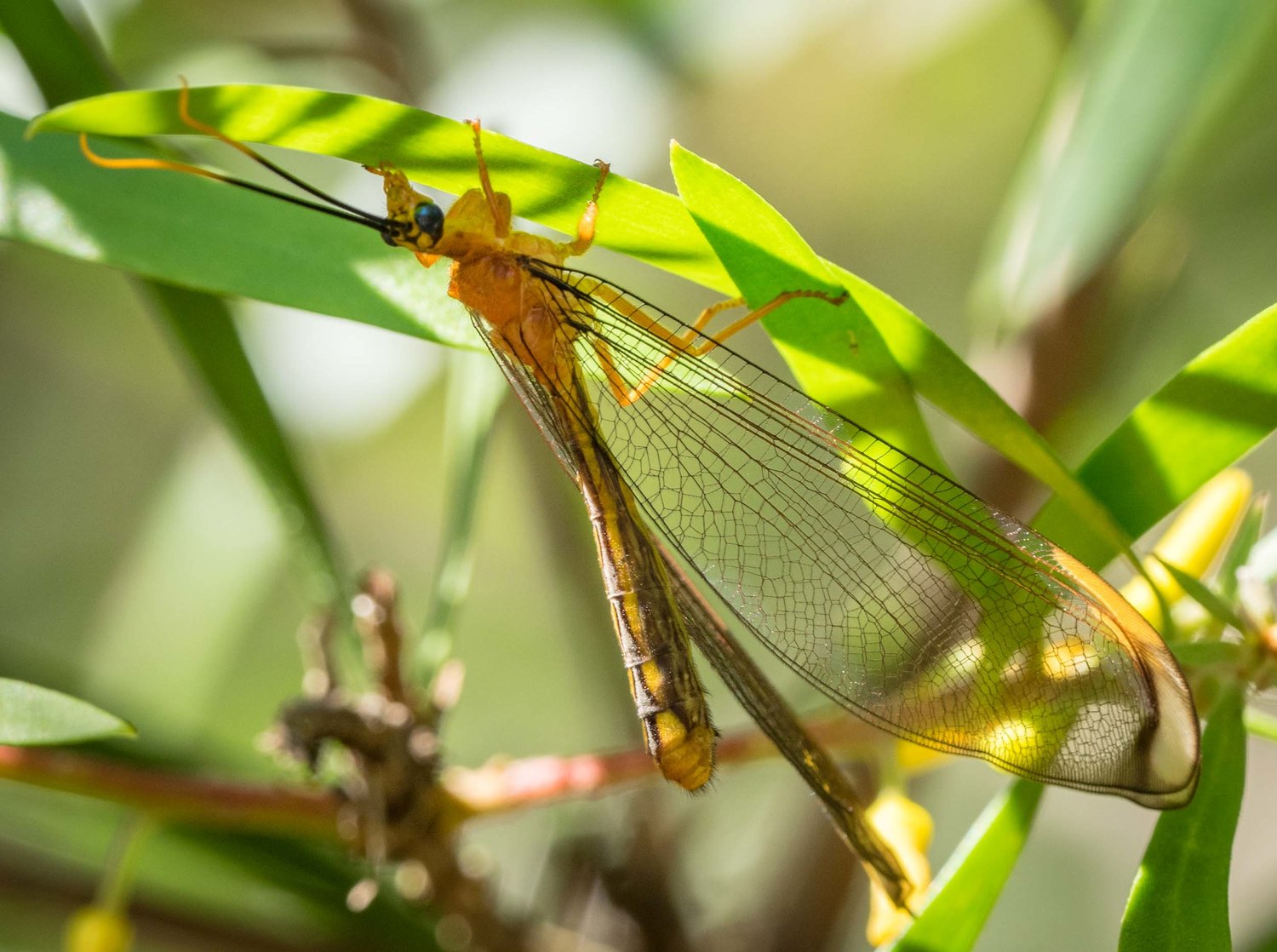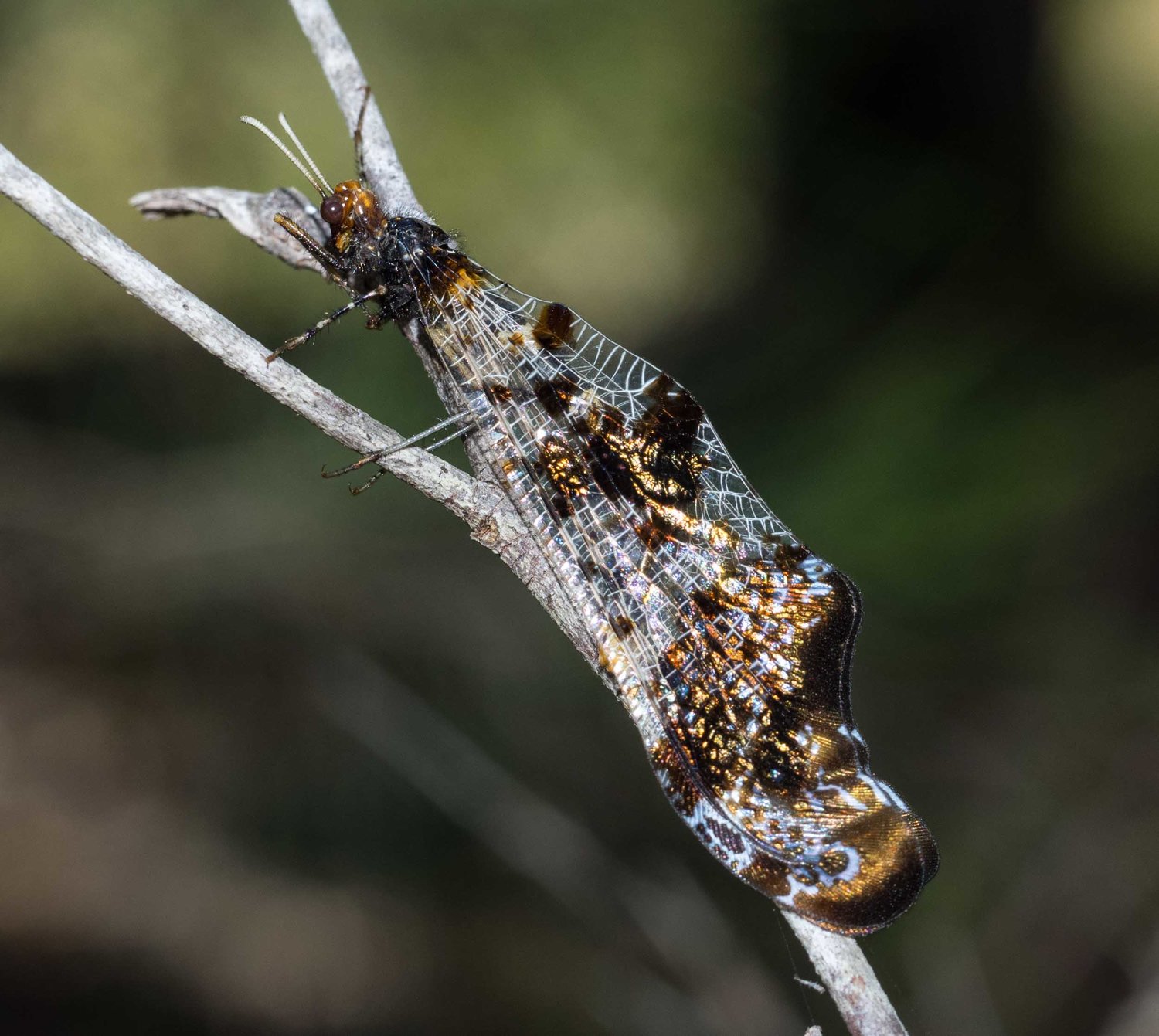Baby lacewings - small but scary

Some lacewings (insect order Neuroptera) lay their eggs in a very neat fashion. Each egg is placed at the end of a long silken thread, which is in turn attached to a plant stem, a leaf or the bark of a tree.
This image shows the characteristic arrangement made by the lacewing Nymphes myrmeleonides.
A different pattern is shown below - a single row of 6 eggs on a longer stalk. It is thought that this egg laying strategy helps to stop larvae eating each other immediately after they hatch.
Yet another variation, which we often see, is shown below - 30 eggs, each 1mm long, radiating out from one side of a daisy stem. Kerri chanced across this clutch on 17th January.
We were keen to observe the larvae that hatched from these eggs. So, over the following days, I examined the eggs under the microscope to keep tabs on their development. I wanted to be prepared for the moment of hatching.
Embryonic Development
It was apparent that on the day we found them, the eggs were at an early stage of development. The embryo took the form of a narrow yellow streak, which extended halfway along the length of the egg - as shown in the image above. But how quickly would they develop?
Four days later the embryo was clearly at a much more advanced stage. It filled the entire length of the egg and distinct segments were apparent.
Hatching
One day later, on 22nd January, it was all happening! Fortuitously, I checked the clutch just as the first larvae were emerging. The images and movies below show how they hatch.
Time 0: The end of the egg opposite its attachment to the stalk splits open and the head starts to emerge. The dark spots are the 6-7 ommatidia, or visual units of the eye. Waves of contraction of abdominal muscles push the embryo out of the opening in the egg, as shown in this video clip of a different embryo.
1:44 mins: The head has now fully emerged, revealing the mouthparts and the eyes. The forelimbs are also out.
2:35 mins: All of the legs have now emerged. Long curved hairs on the back of the thorax have lifted away from the body.
4:43 mins: Most of the abdomen has emerged, revealing the long hairs on its dorsal side. The front pair of mouthparts - whose tips are a reddish-brown colour - are also clearly visible. I'll explain what these are later. The legs have pulled out further, but are still attached to the egg case at their tips.
4:51 mins: The larva suddenly pulls its legs away from the egg case and arches its body backwards.
5:37 mins: The larva arches its body right back, giving a good view of those intimidating mouthparts.
The video below shows this whole sequence of events. I find it fascinating, if disturbingly reminiscent of a scene from 'Alien'.
Not long after the end of this video sequence, the larva had pulled itself away from the egg case completely and was sitting proudly on top. What a beauty! The eyes look cool but with so few ommatidia they are unlikely to provide effective form perception.
The development of this clutch of eggs was quite synchronous. Within 30min almost all of the clutch had hatched. Most of them remained on their empty egg case for the rest of that day, allowing their cuticle to harden.
Here is a shot of six of them, recovering from the trauma of hatching.
Life out of the Egg
I've decided to keep my new babies, for a while at least. I'm curious to see how they grow and develop. The appearance of the hatchlings suggest they belong to the neuropteran family Chrysopidae - green lacewings. If I could rear them through to the adult stage I could confirm that.
But the first problem I face is "what to feed them"? CSIRO's "The Insects of Australia" tells me Chrysopidae larvae are generalist predators, feeding on soft-bodied insect larvae, such as aphids and caterpillars. I thought that psyllids might do the job and found some on a eucalyptus leaf - we've got no shortage in our forest.
This is the nymph of the psyllid Glycaspis sp. It's a bug that sucks juices from the leaf and secretes honeydew as it does so. As a result, a dome of a sugary material - called a lerp - builds up above its body, protecting the nymph beneath. Two lerps can be seen below the exposed nymph in this image.
So I put several of these psyllid nymphs into the container with my lacewing larvae. Not long afterwards I was able to confirm that a psyllid nymph is a perfectly acceptable food item for a lacewing larva.
In this movie you can see that a lacewing larva has grasped a psyllid nymph in its mouthparts and is engaged in a game of tug-of-war, trying to prevent it from escaping.
Here is a series of still photos of lacewing larvae that have been feeding. Note that the cuticle has darkened in the 24 hrs since they hatched from the egg.
View from above. This gives a good view of those long, curved mouthparts, which the larva uses to grasp its prey.
Each of these is actually made up of a pair of mouthparts - the maxilla and the mandible - which fit tightly together to form a functional unit. The mandible is the hard, curved, tan-coloured part, which does the grasping and jabbing bit. The maxilla normally sits in a groove in the mandible and is hollow. It functions as a stylet, delivering an injection of digestive juices to the prey. I've read that the organs of an aphid can be liquified by this within 90 seconds! The broth is then sucked up by the hungry lacewing larva.
A closer look at the mouthparts. The mandible is the outer tan-coloured mouthpart, the maxilla the inner, straw-coloured one.
View from the side. This shows those long hairs on the dorsal side of the thorax and abdomen. So what's that distracting debris on top? That's actually the larva's last meal! It's the carcass of a psyllid nymph, which has been trapped in the hairs.
That's not an accident. The body hairs are designed to trap debris of all sorts to provide camouflage to the lacewing larva. In the wild, this may take the form of bits of leaf, flowers and sticks.
I watched a larva reaching its head back to one of these psyllid carcasses to have another suck of the juices - takeaway food!
So here is a critter that eats aphids and psyllids - undesirable bugs to have in your garden, orchard or eucalypt plantation. Biological control springs to mind. Sure enough, some enterprising individuals have seen the business opportunity. Lacewing eggs for sale!
Two days after hatching
My babies are growing - now 2-3mm long, thriving on their diet of psyllid nymphs. Here is a video of one of them injecting digestive juices into a poor psyllid nymph. It is pursued by a hungry competitor at the end. Get the "small but scary" bit now?





















